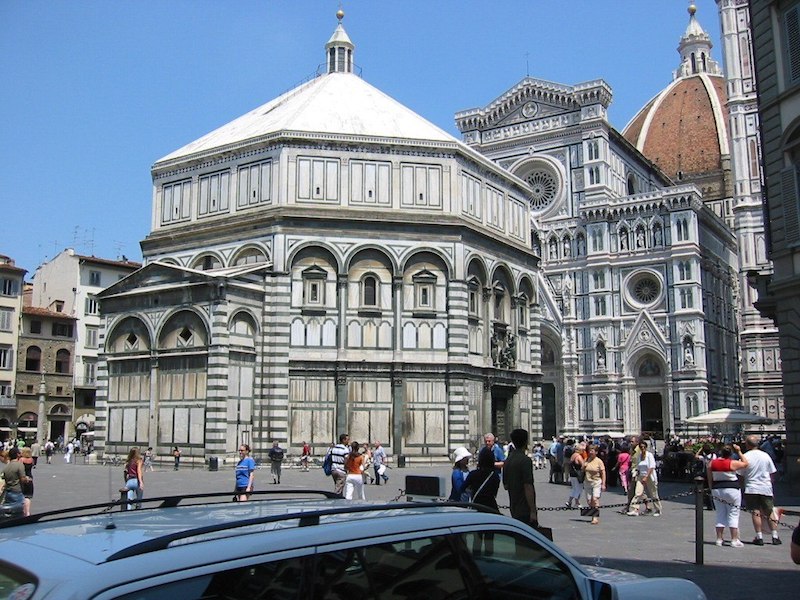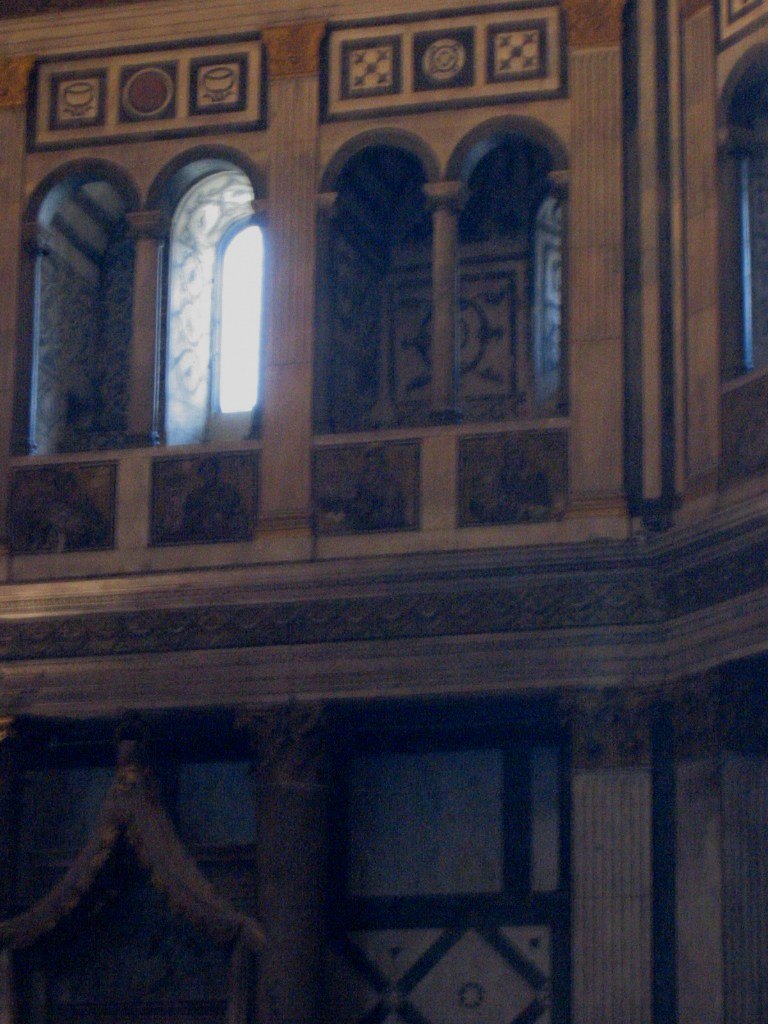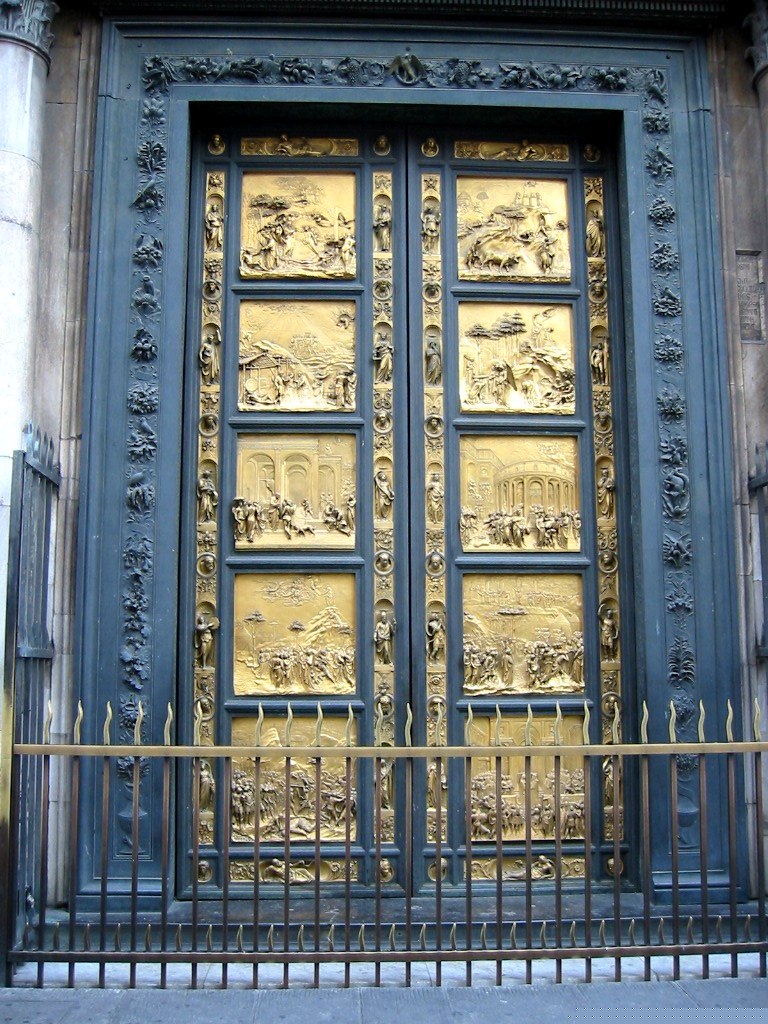
Battistero
With its distinctive shape the Battistero
or Baptistry is one of the most recognizable edifices in Florence.
Standing alongside the Duomo
and the
Campanile in the
Piazza del Duomo, (photo to the left) the Battistero
has a long and distinguished history. Built over the remains of an
ancient Roman palace, it is one of the oldest buildings in Florence.
Any Florentine of any note was baptized here, including the infant
Dante, who was christened here before the Battistero gained its
beautiful marble facade. The
entire outer surface is covered with this design of white and green
marble, added from the 11th to 13th centuries (photo to the right).
Inside, the ceiling
is decorated with mosaics, while above the altar there
are figures of the Virgin and St. John the Baptist, for whom the
structure is dedicated. The mosaic dome shows the Last  Judgement, with
the sinful being devoured by monsters, while the faithful ascend to
heaven. The Baptistery features a tessellated floor with intricate
patterns.
Judgement, with
the sinful being devoured by monsters, while the faithful ascend to
heaven. The Baptistery features a tessellated floor with intricate
patterns. The photo to the immediate right shows the high windows on the northern
side of the Battistero, which lets in the small amount of light
that is used to illuminate the area. Although most of the sculptures
have been removed to the nearby Opera
del Dumo Museum, including the Gates of Paradise and the
sculptures of the Beheading of St.
John by Vincenzo Danti (southern door), St. John the Baptist Teaching between the
Pharisee and the Levite by Giovanni Francesco Rustici (northern
door), and the Baptism of Christ
by Andrea Sansovino (above the Gates
of Paradise). Still
visible in the Baptistry is the tomb of Baladassare Cossa - the
maligned Antipope John XXIII - created by Donatello and Michelozzo.
This is visible in the photo to the left.
The photo to the immediate right shows the high windows on the northern
side of the Battistero, which lets in the small amount of light
that is used to illuminate the area. Although most of the sculptures
have been removed to the nearby Opera
del Dumo Museum, including the Gates of Paradise and the
sculptures of the Beheading of St.
John by Vincenzo Danti (southern door), St. John the Baptist Teaching between the
Pharisee and the Levite by Giovanni Francesco Rustici (northern
door), and the Baptism of Christ
by Andrea Sansovino (above the Gates
of Paradise). Still
visible in the Baptistry is the tomb of Baladassare Cossa - the
maligned Antipope John XXIII - created by Donatello and Michelozzo.
This is visible in the photo to the left.
 From an
aesthetic perspective, the most remarkable feature of the Battistero
are its sets of doors, especially
From an
aesthetic perspective, the most remarkable feature of the Battistero
are its sets of doors, especially those on the
east and south entrances. The east entrance gates (directly across
from the steps of the Duomo) are the creation of the renowned Lorenzo
Ghiberti. Dubbed "The Gates of
Paradise" by Michelangelo, the door is
divided into ten panel depicting Old Testament scenes. (photo
to the left) Noted for their use of perspective and detail, the two
sets of doors (the north doors as well as the east doors) occupied the bulk
of the artist's life work. He labored on his masterpiece from 1425-1452--a total of 49 years to
finish the doors. The photo to the right shows one of the panels from
the "Gates of Paradise." It depicts Moses receiving the Ten
Commandments. These doors are, however, copies, as the originals are
safely stored from weather in the nearby Museo dell'Opera.
those on the
east and south entrances. The east entrance gates (directly across
from the steps of the Duomo) are the creation of the renowned Lorenzo
Ghiberti. Dubbed "The Gates of
Paradise" by Michelangelo, the door is
divided into ten panel depicting Old Testament scenes. (photo
to the left) Noted for their use of perspective and detail, the two
sets of doors (the north doors as well as the east doors) occupied the bulk
of the artist's life work. He labored on his masterpiece from 1425-1452--a total of 49 years to
finish the doors. The photo to the right shows one of the panels from
the "Gates of Paradise." It depicts Moses receiving the Ten
Commandments. These doors are, however, copies, as the originals are
safely stored from weather in the nearby Museo dell'Opera.
Not to be overlooked are the south set of doors, the creation of Andrea Pisano, who also aided in the design of the nearby Campanile. Completed in 1336, they too depict biblical scenes in a series of 28 panels, smaller than those found in Ghiberti's "Gates of Paradise." The photo to the left shows the south Baptistery doors, while the close-up to the right depicts a baptismal scene.